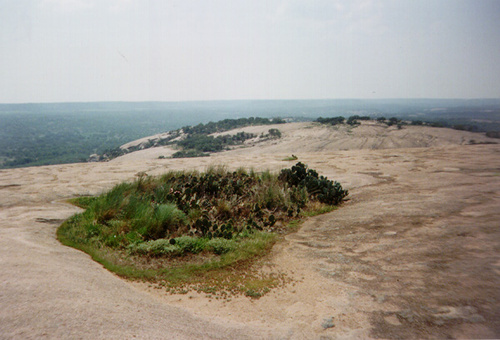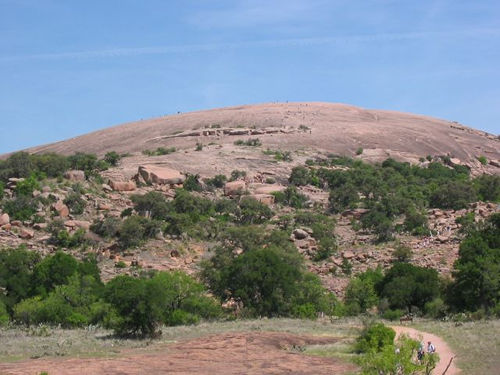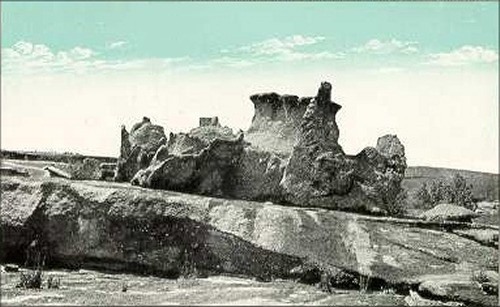|
Getting
There
Enchanted Rock State Natural Area
From Llano
-
Hwy 16 South for 14 miles, then west on Ranch Road 965.
16710 Ranch Rd 965, Fredericksburg,
TX 78624
325/247-3903 |
"View of
Enchanted Rock from base camp."
Jackpaylor, February 2016
Wikimedia Commons |
| Located
twenty miles north of Fredericksburg
in the southwestern region of Llano
County, Enchanted Rock serves as the geological center of the
Lone State State. Scientists classify the pink granite dome as a monadnock,
an isolated rock formation which has been pushed above ground by hardened
magma rock called a batholith. A Monadnocks is actually a part of
the batholith that pushed it upward past the surface. The one responsible
for Enchanted Rock is named the Town Mountain Granite. |
The second largest monadnock in the nation, eclipsed only by Stone
Mountain in Georgia near Atlanta, Enchanted Rock is the centerpiece
of a state park covering 1,643 acres. Enchanted Rock State Natural
Area is home to more than four hundred archaeological sites, five
hundred plant species, and a chain of small granite domes. Considered
a national landmark and archaeological district, the park annually
receives more than 250,000 visitors.
Enchanted Rock acquired its name from the early inhabitants of the
region. They witnessed strange, eerie lights and fires coming from
the top of the structure. Those who approached it also claimed to
hear cries and groans filling the air. They attributed such things
to magic and the supernatural. According to scientists, the lights
and fires could have been the moonlight shining off the rock's surface
after a good rain storm. Layers of rock contracting during cool temperatures
after being subjected to heat would account for the unusual noises.
|
The
first settlers of the Enchanted Rock region arrived at the scene 11,000
years ago. Although no identification has been given to the inhabitants,
archaeologists determined the society was divided into hunters and
gatherers and served as a heavy influence on the tribes of the Plains
Indians. These ancestors literally left their mark on Enchanted Rock
by making strong depressions in the structure as they prepared their
food.
The Tonkawa tribe,
which name means "they all stay together", became the first known
Native Americans to occupy Enchanted Rock and its surroundings. The
Tonkawa society was founded during the 1400s in Texas and Oklahoma.
However, the people didn't move into the Llano
area until the sixteenth century. The Tonkawa
continued to thrive until disease and war against the Apache weakened
their numbers. The war itself was made worse by the fact that the
Tonkawa alienated themselves from other tribes by the practice of
cannibalism. The Apache succeeded in driving them away from Enchanted
Rock during the 1700s, who were then replaced by the Comanche near
the end of the same century.
The three tribes had many superstitions pertaining to the granite
dome such as the belief that the rock served as a portal to unknown
worlds, invisibility could be obtained at night on the structure,
and bad things would happen to those who climbed it with evil intentions
in their heart. They also contributed legends and ghost stories. Indentations
on the apex of the rock were actually the footprints of an Indian
chief's spirit forced to walk along the top for all eternity because
he had sacrificed his daughter. Phantom warriors of an extinct tribe
haunted the rock after unsuccessfully defending themselves against
enemy foes. Following the slaughter of her people, a princess committed
suicide, causing her spirit to roam the area.
Spanish
exploration into Texas started with Alvar
Nunez Cabeza de Vaca in 1536. Although the expedition entered
the region, it went nowhere near the hill
country. Other Spaniards spread stories and rumors of wealth.
Enchanted Rock itself was referenced as a large clump of silver or
iron, depending on the storyteller. Regardless, the Spanish government
showed little interest in Texas until the French established a colony
at Fort
St. Louis near Matagorda Bay in 1685. Despite the colony's failure,
Spain went into action and established several missions in the San
Antonio area. Officials then focused their attention on the hill
country, hoping to find a suitable place to build an outpost and
convert the Apache to Christianity. The warriors near the fortification
would serve as a protective barrier to prevent Comanche attacks on
San Antonio.
In 1753, Lieutenant Juan Galvan led an expedition to find a place
to erect a mission. He explored the Pedernales
and Llano Rivers
before arriving at the San
Saba. Galvan felt he had found the perfect spot, but he later
sent a second team to back up his findings. When the men came back,
they returned with Indian tales of the Hill of Red Ochre. Rumors immediately
spread about the possibility of gold and silver in the Llano region.
Enchanted Rock received some attention, but the majority went elsewhere.
There were many legends that arose during the time of Spanish rule.
According to one account, the Tonkawa
captured a conquistador. He escaped, however, by hiding on Enchanted
Rock. The man later claimed that the rock had conjured some kind of
magic spell. In another tale, a group of Indians pursued a priest
all the way to the rock. The priest fell into a cavern and spent two
days going through its tunnels and meeting several ghosts. The most
famous legend involved a soldier named Don Jesus Navarro. He traveled
to a mission in San Antonio
and fell in love with a young Indian maiden called Rosa. The daughter
of Chief Tehuan, she was abducted by a group of Comanche warriors.
Just as they were about to burn her alive at the stake on Enchanted
Rock, Navarro arrived on the scene and rescued his true love.
|
 |
"Vernal
pool at the top of Enchanted Rock in 1998."
James L. Stuby
Wikimedia Commons |
In
1821, the Mexican people won their independence from the Spanish governement
and set up a new republic. The new leaders wanted to protect the northern
territories from the westward expansion that was taking place. To
this end, they decided to populate the area with more settlers. The
government tried appealing to Europeans first, but failed in the endeavor.
The only option left, ironically, was the recruitment of Americans.
Stephen F. Austin
led the first group of settlers in 1822 and founded San
Felipe de Austin.
The colonists soon found themselves facing the fierce Indian tribes,
especially in the hill
country. In addition to the deadly Comanche of the region, the
families had to deal with a mixture of Cherokee, Shawnee, Caddo, Kiowa,
Arapaho, Cheyenne, and Apache. This did not deter the new inhabitants,
thanks to the stories of mines containing gold and silver along the
Llano and
San
Saba River.
The constant friction with the Indians often led to the spreading
of rumors regarding Enchanted Rock. Tales surfaced of the Comanche
performing ritual sacrifices on the rock. These attempts to vilify
the tribes were sometimes accompanied by stories about their reverence
toward the rock. All of them involved the narrator trying to escape
certain death from the Indians. In each case, the storyteller would
reach the safety of Enchanted Rock, a place where the pursuers would
stop and end the chase, sometimes refusing to fire their arrows. The
most famous legend during this time involved some Indians who kidnapped
a woman. The lady managed to escape and sought a place to hide. After
reaching Enchanted Rock, she stayed there until she died from starvation.
Many people claimed they could hear screams at night when they got
near the rock.
In 1829, Captain Henry S. Brown went on an expedition to hunt down
the Indians responsible for attacking and terrorizing Austin's colony.
He had two successful battles along the journey, the second one taking
place at Enchanted Rock. When he returned from the long trek, Brown
gave a detailed description of the granite dome and received credit
for discovering it.
The
Texas Revolution came to a successful conclusion in 1836 after the
Battle of San
Jacinto. News of a new government did not end the excitement over
the possibility of discovering rich mines. Speculators and surveyors
flooded Indian territory, causing deeper conflict with the settlers.
This growing ordeal made ownership of Enchanted Rock an impossibility.
Nevertheless, Anavato Martinez and his wife Maria Jesusa Trevino managed
to secure a deed to the natural formation and its surrounding area
in March 1838.
Later that same year, James Webster and his family made a trip to
obtain a headright, but a group of Comanche led by Chief Buffalo Hump
attacked them. They killed everyone except the wife and two of her
children. Before anyone could come to the rescue, the chief split
up his forces and met again at Enchanted Rock. Two years later, the
captives managed to escape and found their way to San
Antonio. It was there that she started telling about gold, silver,
and diamonds. Adding veracity to her claims a year later in 1841,
a British diplomat William Kennedy published a book called Texas after
he had visited the state to explore the frontier and hopefully find
some riches. The book became successful and enticed Germans to immigrate
to the new nation.
In addition to the book publication, the year of 1841 saw a legendary
tale unfold, thanks to the actions of a Texas Ranger. Born in Tennessee,
John
Coffee Hays began a career as a surveyor in Mississippi. He returned
to Tennessee briefly to attend Davidson Academy then moved to Texas
to join the revolution. Following the advice of Sam
Houston, Hays joined a group of rangers under the leadership of
Erastus Smith and soon found himself promoted to the rank of sergeant.
After the war, Hays mixed his surveying duties with his military ones.
Hays became a captain in 1840, often helping citizens and Indian allies
fight against Mexicans and Comanches.
On one fateful day, Captain Hays went on a scouting expeditions for
some surveyors. Everything was going well until he found himself separated
from his team. As luck would have it, a large group of Comanches appeared
on the scene and attacked the lone figure at the base of Enchanted
Rock. Hays pulled out his colt revolver, firing it as he retreated
of the ragged dome. He found a crevice then turned around to face
his pursuers. He fired upon the Indians, standing his ground for three
hours. Single-handedly, Hays fended off the Indians until his group
was able to join the fray. The Comanche decided to leave the area,
not wanting to increase the number of casualties.
Despite the dangers illustrated with this tale, people continued to
show interest in the Llano
region. Anavato Martinez sold ownership of Enchanted Rock and
its surrounding area to James W. Robinson in October 1841. During
the Texas Revolution, the former politician had served as the lieutenant
governor in 1835 then took the governor's seat in 1836. Robinson spent
the rest of his career as a district judge of the Texas Supreme Court.
Three years after Robinson acquired the property, his business partner
Samuel Maverick bought the land in hopes that it would bring him more
wealth. A politician and land baron, he earned the reputation of being
independent by refusing to brand his cattle. The locals of Matagorda
Bay began calling them mavericks and a new term was born.
Taxation,
overpopulation, and signs of autocracy led many citizens to seek refuge
from the German Confederation, a group of 39 states brought together
by the Congress of Vienna after Napoleon had been defeated. To help
accomplish this goal, several noblemen led by Prince Solms formed
an organization called the Society for the Protection of German Immigrants
in Texas during April 1842. Feeling that Texas was the perfect place
for a new life, the commissioner general made a down payment on a
land grant acquired by Henry Francis Fischer and Burchard Miller.
Unfortunately for the Germans, the grant covered 1,735,200 acres of
Indian territory, effectively making the area uninhabitable.
The immigrants arrived in Galveston
in July 1844 then started their journey to Indianola.
From there, they planned to move onward to the Ficscher-Miller Land
Grant. However, Captain John Hays convinced Prince Solmes that the
settlers would not have the time to make the journey and establish
the colony before winter started. Solmes bought two leagues of land
northeast of San Antonio
near Comal Springs. This led to the establishment of New
Braunfels.
John O. Meusebach took over the commissioner general position in 1844
and arrived in Galveston
the following year. The job had become too burdensome for Prince Solmes,
who felt overburdened with all the responsibilities that came with
it. The organization was on the brink of bankruptcy from financial
management while 439 settlers waited to make the final leg of the
journey. On top of all this, the Comanche roamed the prospective land
which had to be occupied by August 1847. Failure to miss the deadline
would mean termination of the contract and the end of their colonization
efforts.
In response to the deadline, Meusebach founded Fredericksburg
in May 1846, then began an expedition to make peace with the Comanche
in January 1847. He met with tribe leaders Old Owl, Santa Anna, and
Buffalo Hump two months later and succeeded
in making a treaty. The Germans obtained permission to settle
in an area of 3,878,000 acres without fearing Comanche aggression
in exchange for 3,000 dollars worth of gifts. Furthermore, the tribe
would protect them from other Indians if they helped the Comanche
against horse thefts and other crimes committed by enemy tribes. This
agreement led to the establishment of Concho,
Kimble, Llano,
Mason, Menard,
McCulloch, San
Saba, Schleicher,
Sutton, and Tom
Green counties. In addition, Enchanted Rock and the surrounding
region would no longer experience aggression from the Comanche tribe.
Samuel
Maverick's wife sold the land rights to Enchanted Rock to N. P. P.
Browne around 1880, but she insisted on keeping the mineral rights.
Six years later, John R. Moss bought it then gave the ownership to
C. T. Moss, J. D. Slaytor, and A. F. Moss in 1887. Slaytor relinquished
his share of the land in 1896. Although the Moss Family maintained
control, the members allowed the rock and the surrounding area to
be used for church gatherings, concerts, parties, picnics, and other
public functions. When Tate Moss gained ownership in 1927, he made
Enchanted Rock a privately-operated park and opened it to the general
public. During 1946, Albert Faltin purchased the ranite dome then
sold half of the ownership to Charles H. Moss in 1947. Charles kept
the rights until 1978.
That fateful year in March, Charles Moss announced that he would be
selling Enchanted Rock. He first went to the Texas Parks and Wildlife
Department, but the asking price of 1.3 million dollars was too expensive.
After the rejection, a multitude of rock quarry companies and development
firms appeared on the scene. There was even an offer to transform
the dome into a monument similar to Mount Rushmore. |
 |
"Enchanted
Rock as viewed from the trail leading to the summit. People climbing
on the summit (visible as dots) give an idea of the scale of the granite
rock."
30° 30' 20" N, 98° 49' 05" W
Claygate, April 14, 2006
Wikimedia Commons |
Lady
Bird Johnson, the widowed wife of former president Lyndon B. Johnson,
decided to come to the rescue. She contacted The Nature Conservancy
and persuaded the non-profit organization to buy Enchanted Rock. The
Nature Conservancy then gave the land to the State of Texas, which
took control in June after adding three acres to the property. In
October 1978, the government opened Enchanted Rock to the pubic as
a state natural area. The Texas Parks and Wildlife Department closed
Enchanted Rock in 1982 to make improvements. These changes included
tent sites, picnic areas, campsites, hiking trails, and a visitor
center. Eighteen months later, the park reopened and was added to
the National Registry of Archaeological Sites. The Friends of Enchanted
Rock was formed during the late 1990s and took on the task of raising
money to help maintain the park. The granite formation attracts more
than 250,000 people each year.
June 26, 2017
© Clint
Skinner |
 |
Enchanted Rock
Postcard
courtesy www.rootsweb.com/ %7Etxpstcrd/ |
|
SOURCES
Allred, Lance. Enchanted Rock : A Natural and Human History.
University of Texas Press : Austin, 2009
Commons-Brosowske, Carol. Legends of Enchanted Rock. Texashillcountry.com,
April 1, 2016
Friendsofenchantedrock.com
Kennedy, Ira. The Enchanted Rock. Texfiles.com, 1999
Nelson, Katie Armstrong. "Enchanted : A Natural and Legendary History
of Enchanted Rock". Texas Parks & Wildlife Magazine. December 2008
Slackerpacker.com
Tshaonline.org
Wikipedia.org
|
|
Anyone
wishing to share information, stories or photos of
Enchanted Rock and other state parks in Texas, please submit
here. |
|
|
